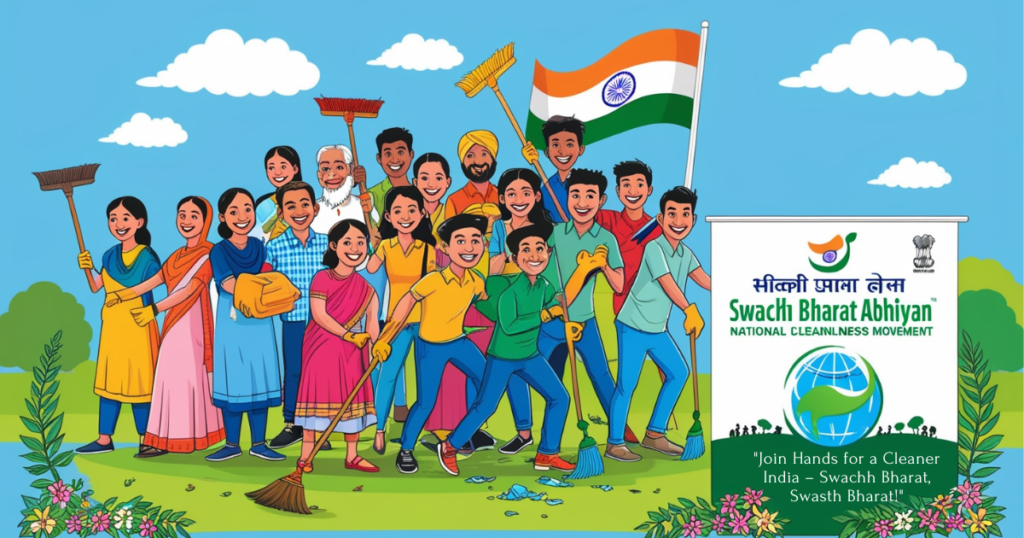Summary: Swachh Bharat Abhiyan
Swachh Bharat Abhiyan, launched in 2014, aims to achieve a clean India by eradicating open defecation, improving waste management, and promoting hygiene. It emphasizes rural and urban sanitation, community participation, and technology for sustainable cleanliness and public health improvements.
Introduction to Swachh Bharat Abhiyan
Swachh Bharat Abhiyan, or the Clean India Mission, is a nationwide initiative launched by the Government of India on October 2, 2014, under the leadership of Prime Minister Narendra Modi. This ambitious campaign aims to achieve a clean and hygienic India by promoting sanitation, eradicating open defecation, and improving waste management systems. Dedicated to the memory of Mahatma Gandhi, who championed cleanliness, Swachh Bharat Abhiyan aspires to realize his vision of a clean and prosperous nation.

Objectives of Swachh Bharat Abhiyan
The Swachh Bharat Abhiyan has several well-defined objectives that target various aspects of cleanliness and sanitation:
- Eradication of Open Defecation: Eliminating open defecation through the construction of household and community toilets.
- Improved Waste Management: Promoting scientific waste segregation, disposal, and recycling practices.
- Behavioral Change: Encouraging citizens to adopt hygienic habits and maintain cleanliness in their surroundings.
- Infrastructure Development: Building sanitation facilities, such as public restrooms and waste disposal units, across urban and rural areas.
- Promotion of Awareness: Educating people about the importance of cleanliness and its impact on public health.
Impact of Swachh Bharat Abhiyan
Rural Sanitation: A Revolution
One of the most significant achievements of Swachh Bharat Abhiyan is its impact on rural sanitation. The campaign has constructed millions of toilets in villages, leading to a dramatic reduction in open defecation. According to official statistics, rural sanitation coverage in India increased from 39% in 2014 to over 100% by 2019, with many villages being declared Open Defecation Free (ODF).
Urban Cleanliness and Waste Management
In urban areas, Swachh Bharat Abhiyan has introduced initiatives like door-to-door waste collection, segregation of biodegradable and non-biodegradable waste, and the development of solid waste management plants. Cities have adopted advanced techniques such as waste-to-energy conversion, making significant strides in tackling urban waste issues.
Health and Hygiene Benefits
The campaign has directly contributed to improved public health. By reducing open defecation and promoting better hygiene, the incidence of diseases such as diarrhea, cholera, and malaria has decreased significantly. Access to clean water and sanitation facilities has also enhanced the overall quality of life.
Key Components of Swachh Bharat Abhiyan
Swachh Bharat Mission (Gramin)
Focusing on rural areas, this component of the mission emphasizes toilet construction, sanitation awareness, and behavior change among rural communities. Financial incentives and subsidies have been provided to households for building toilets, empowering millions to improve their living standards.
Swachh Bharat Mission (Urban)
Targeting urban cleanliness, this segment addresses challenges like waste management, public restroom availability, and cleaning of urban spaces. Initiatives like the Swachh Survekshan—an annual cleanliness survey—motivate cities to compete for the title of India’s cleanest city.
Behavioral Change Campaigns
Swachh Bharat Abhiyan has launched innovative awareness programs, including:
- Community Engagement: Encouraging local participation in cleanliness drives.
- Educational Campaigns: Spreading awareness through schools, colleges, and public platforms.
- Celebrity Endorsements: Leveraging influential personalities to inspire citizens.
Role of Technology in Swachh Bharat Abhiyan
Modern technology has played a pivotal role in the success of Swachh Bharat Abhiyan. Tools such as mobile applications, GPS tracking systems, and real-time monitoring dashboards have been utilized to track progress, report issues, and ensure accountability. For example, the Swachhata App enables citizens to report unclean areas, ensuring prompt action by municipal authorities.
Community Participation: The Heart of the Mission
The success of Swachh Bharat Abhiyan heavily depends on community participation. Citizens, non-governmental organizations (NGOs), and corporates have come together to contribute to cleanliness drives, donate resources, and spread awareness. Public-Private Partnerships (PPPs) have also been instrumental in funding and implementing waste management projects.
Challenges Faced by Swachh Bharat Abhiyan
Despite its remarkable achievements, Swachh Bharat Abhiyan has faced certain challenges:
- Sustainability of Infrastructure: Ensuring long-term maintenance of constructed toilets and waste management facilities.
- Behavioral Resistance: Overcoming deep-rooted cultural practices and beliefs that hinder the adoption of hygienic habits.
- Urban Waste Overload: Managing the increasing volume of urban waste due to population growth and industrialization.
Success Stories: Cities and Villages Leading the Way
Several cities and villages have emerged as shining examples of success under the Swachh Bharat Abhiyan:
- Indore: Consistently ranked as India’s cleanest city in Swachh Survekshan.
- Madhubani (Bihar): Famous for its cleanliness initiatives and wall art promoting hygiene.
- Kerala: A pioneer in achieving 100% sanitation coverage and efficient waste management.
The Role of Individuals in Swachh Bharat Abhiyan
While the government has laid the foundation for Swachh Bharat Abhiyan, its success ultimately rests on the shoulders of every citizen. Simple actions like proper waste segregation, using dustbins, and avoiding littering can contribute significantly to the mission’s goals. Additionally, volunteering for cleanliness drives and spreading awareness in local communities can create a ripple effect.
Conclusion: Towards a Cleaner India
Swachh Bharat Abhiyan is more than just a government initiative; it is a movement that unites the entire nation under the common goal of cleanliness and hygiene. By addressing critical issues like sanitation, waste management, and public health, this campaign is paving the way for a clean, green, and sustainable future. As responsible citizens, it is our duty to uphold the principles of this mission and work collectively to make India a global example of cleanliness.